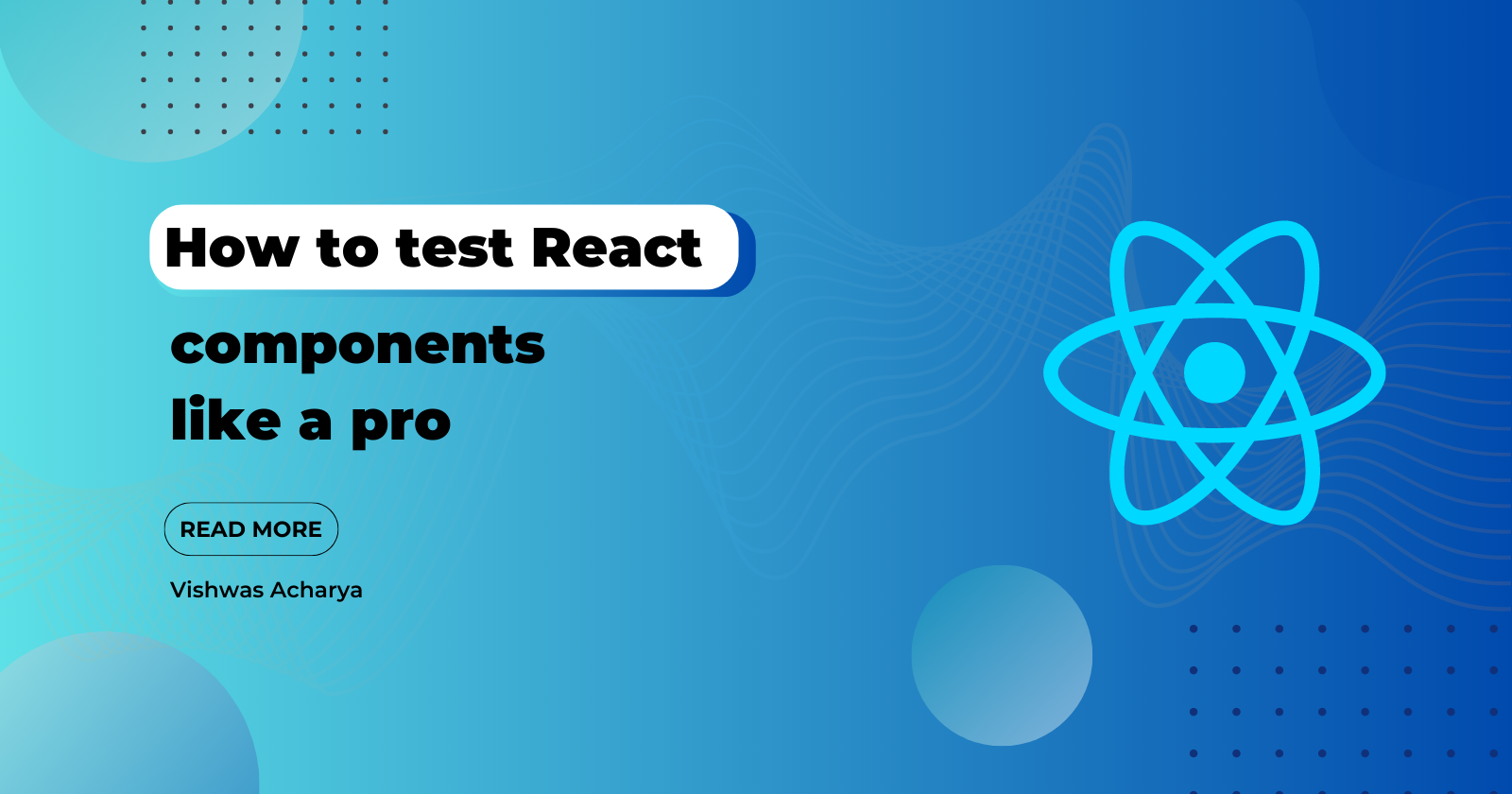How to test your React components like a pro
 Vishwas Acharya
Vishwas Acharya
Introduction
React is a popular JavaScript library used for building user interfaces, and it's important to ensure that your components are thoroughly tested to guarantee their functionality and reliability. Testing React components can be challenging, but with the right tools and techniques, you can become a pro at it. In this article, we'll explore various strategies and best practices for testing React components to help you achieve robust and maintainable code.
Setting up the Testing Environment
Before diving into testing your React components, you need to set up a testing environment. The most common tools for testing React applications are Jest, Enzyme, and React Testing Library. These tools provide a comprehensive framework for testing different aspects of your components. You can install them using npm or yarn and configure them to work with your React project.
Unit Testing
Unit testing is the process of testing individual units or functions of your code in isolation. In React, unit testing involves testing your components' behavior and ensuring they produce the expected output.
Testing Stateful Components
Stateful components in React manage their own state and often have complex logic. When testing stateful components, you can use Jest and Enzyme to simulate different scenarios and verify the component's behavior. By setting the initial state, triggering events, and checking the expected output, you can ensure that your stateful components work as intended.
Testing Stateless Components
Stateless components, also known as functional components, don't have their own state and focus on rendering UI based on props. Testing stateless components involves checking if they render the correct output based on different props and edge cases. React Testing Library provides a simple and effective way to test stateless components by querying the rendered DOM and asserting the expected results.
Integration Testing
Integration testing ensures that multiple components work together correctly. It involves testing the interactions and collaborations between different components.
Testing Component Interactions
To test component interactions, you can use tools like Enzyme and React Testing Library to mount your components and simulate user interactions. By triggering events and checking if the expected changes occur in the UI or state, you can verify that your components interact as expected.
Mocking Dependencies
In real-world applications, components often have dependencies on external services or APIs. To isolate your components during testing and prevent unwanted side effects, you can mock these dependencies. By mocking API responses or simulating different scenarios, you can test your components' behavior independently.
Snapshot Testing
Snapshot testing is a useful technique to ensure UI consistency and detect unintended changes. It involves capturing a snapshot of the component's rendered output and comparing it with a stored snapshot. Jest provides built-in support for snapshot testing, allowing you to easily detect any unexpected changes in your component's structure or appearance.
Testing Asynchronous Operations
React components
often involve asynchronous operations, such as fetching data from an API or handling promises. Testing these asynchronous operations ensures that your components work correctly in different scenarios.
Testing Promises
When testing promises, you can use the async/await syntax along with Jest's resolves and rejects matches to handle the asynchronous flow. By awaiting the promise resolution and asserting the expected result, you can verify that your components handle promises correctly.
Testing Async/Await
React Testing Library provides utilities like waitFor and waitForElementToBeRemoved to handle asynchronous operations in your tests. These utilities allow you to wait for specific conditions to be met before proceeding with your assertions, ensuring that your components properly handle async/await operations.
Code Coverage
Code coverage measures the extent to which your tests cover your codebase. It's a useful metric to ensure that your tests adequately validate your components and catch potential bugs. Tools like Jest provide built-in code coverage reports, allowing you to identify areas that need additional testing and improve overall code quality.
Continuous Integration
Integrating testing into your continuous integration (CI) process ensures that your code is tested automatically on every code change. Services like Travis CI, CircleCI, or GitHub Actions can be set up to run your tests and provide feedback on the code's quality and stability.
Debugging Tests
When writing tests, you may encounter scenarios where a test fails or behaves unexpectedly. In such cases, it's essential to have proper debugging techniques in place. Tools like Jest provide helpful debugging features like console.log statements, breakpoints, and the ability to run tests in a watch mode, allowing you to narrow down issues and fix them efficiently.
Performance Testing
In addition to functional testing, it's crucial to test the performance of your React components. Performance testing helps you identify bottlenecks and optimize your code to ensure a smooth user experience. Tools like React Profiler and Lighthouse can assist in measuring performance metrics and identifying areas for improvement.
Best Practices for React Testing
To become a pro at testing React components, it's important to follow best practices. Some key practices include writing clear and concise test cases, keeping tests independent and isolated, using descriptive test names, organizing tests in logical directories, and regularly refactoring and updating your tests to match code changes.
Conclusion
Testing React components is an integral part of the development process, and by following the strategies and best practices outlined in this article, you can become proficient at testing your React components like a pro. Thoroughly testing your components ensures their reliability, improves code quality, and enhances the overall user experience.
FAQ
Q. Why is testing React components important?
A. Testing React components is crucial because it helps ensure their functionality and reliability, and prevents potential bugs or issues in production.
Q. What tools can I use to test React components?
A. Some popular tools for testing React components are Jest, Enzyme, and React Testing Library.
Q. How can I test stateful components in React?
A. Stateful components can be tested by simulating different scenarios using tools like Jest and Enzyme and verifying the expected behavior.
Q. What is snapshot testing in React?
A. Snapshot testing involves capturing a snapshot of a component's rendered output and comparing it with a stored snapshot to detect unintended changes.
Q. How can I integrate testing into my continuous integration process?
A. You can integrate testing into your CI process by using services like Travis CI, CircleCI, or GitHub Actions to automatically run tests on every code change.
By Vishwas Acharya 😉
Checkout my other content as well:
YouTube:
Podcast:
Book Recommendations:
Subscribe to my newsletter
Read articles from Vishwas Acharya directly inside your inbox. Subscribe to the newsletter, and don't miss out.
Written by

Vishwas Acharya
Vishwas Acharya
Embark on a journey to turn dreams into digital reality with me, your trusted Full Stack Developer extraordinaire. With a passion for crafting innovative solutions, I specialize in transforming concepts into tangible, high-performing products that leave a lasting impact. Armed with a formidable arsenal of skills including JavaScript, React.js, Node.js, and more, I'm adept at breathing life into your visions. Whether it's designing sleek websites for businesses or engineering cutting-edge tech products, I bring a blend of creativity and technical prowess to every project. I thrive on overseeing every facet of development, ensuring excellence from inception to execution. My commitment to meticulous attention to detail leaves no room for mediocrity, guaranteeing scalable, performant, and intuitive outcomes every time. Let's collaborate and unleash the power of technology to create something truly extraordinary. Your dream, my expertise—let's make magic happen! Connect with me on LinkedIn/Twitter or explore my work on GitHub.